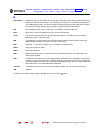
142 SBG1000 Wireless Cable Modem Gateway User Guide
Home
X
ExitPrint
Overview Installation Troubleshooting Contact FAQ Specifications Glossary License
Configuration: Basic Gateway TCP/IP Wireless Print Server USB
Q
To return to your previous page, click the Acrobat Go to Previous View button.
port triggering A mechanism that allows incoming communication with specified applications. Primarily used for
gaming applications.
PPP Point-to-Point Protocol is used to transport other protocols, typically for simple links over serial lines. It
is most commonly used to access the Internet with a dial-up modem.
PPTP Point-to-Point Tunneling Protocol encapsulates other protocols. It is a new technology to create VPNs
developed jointly by several vendors.
private IP
address
An IP address assigned to a computer on the SBG1000 LAN by the DHCP server on the SBG1000 for
a specified lease time. Private IP addresses are used by the SBG1000 LAN only; they are invisible to
devices on the Internet. See also public IP address.
protocol A formal set of rules and conventions for exchanging data. Different computer types (for example PC,
UNIX, or mainframe) can communicate if they support common protocols.
provisioning The process of autodiscovery or manually configuring a cable modem on the CMTS.
PSTN The public switched telephone network is the traditional circuit-switched, voice-oriented telephone
network. See also POTS.
public IP
address
The IP address assigned to the SBG1000 by the cable service provider. A public IP address is visible
to devices on the Internet. See also private IP address.
QAM Quadrature Amplitude Modulation uses amplitude and phase modulation to encode multiple bits of
data in one signaling element. QAM achieves faster data transfer than amplitude or phase modulation
alone, but the signal is more prone to errors caused by noise. QAM requires a transmission circuit with
a higher CNR than alternate modulation formats such as QPSK. Two types of QAM are:
• 16 QAM encodes four bits per symbol as one of 16 possible amplitude and phase combinations.
• 64 QAM encodes six bits per symbol as one of 64 possible amplitude and phase combinations.
QPSK Quadrature Phase Shift Key (QPSK) modulation sends two bits of information per symbol period with
one symbol 90 degrees out of phase with other symbols. The four constellation points represented by
the coordinates (0,0 - 0,1 - 1,0 - 1,1) represent the four possible combinations.
QoS Quality of service describes the priority, delay, throughput, and bandwidth of a connection.


















